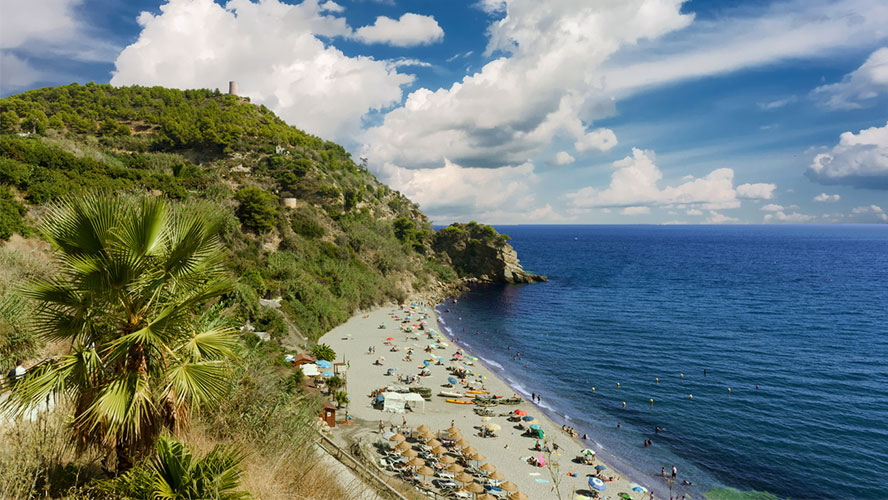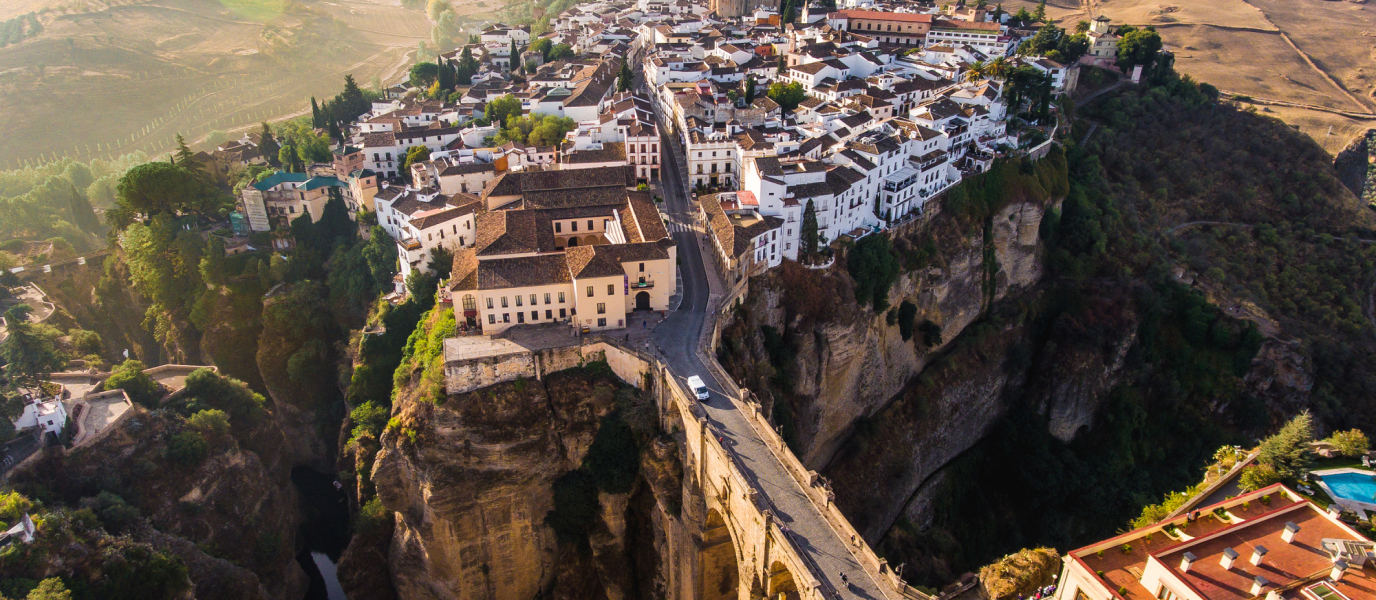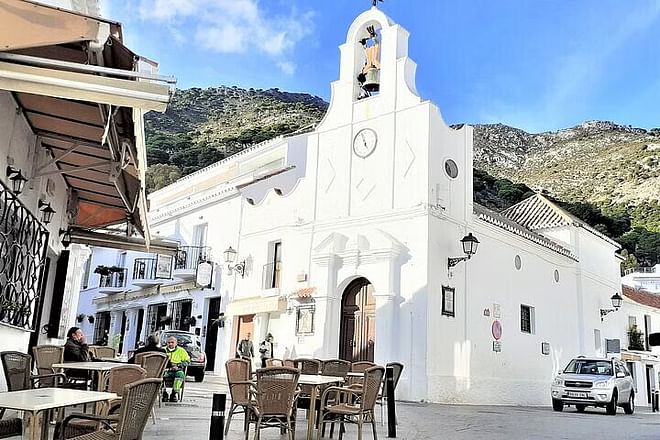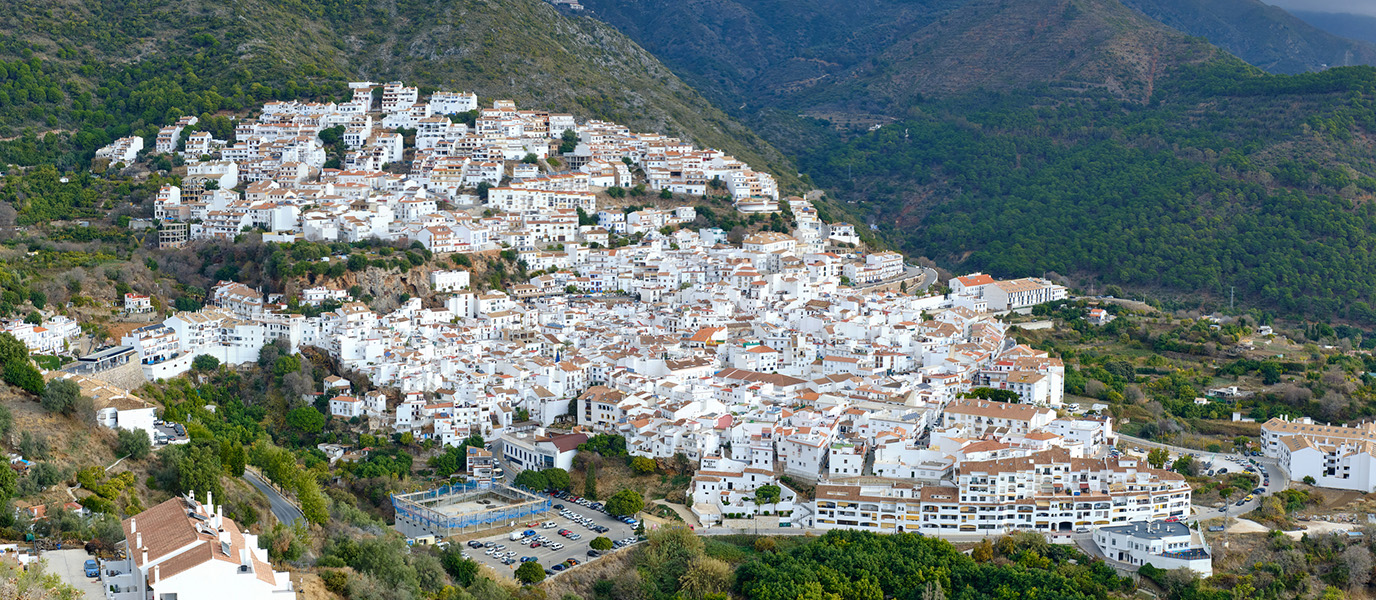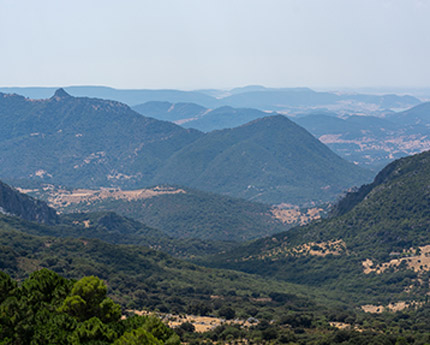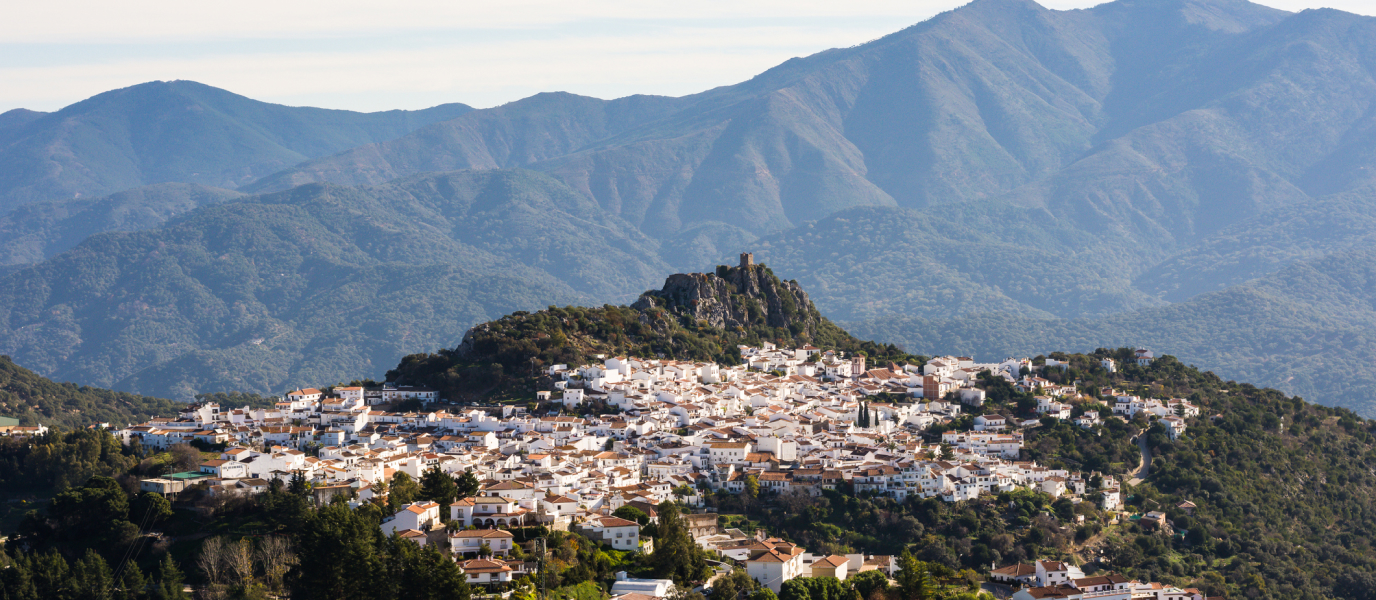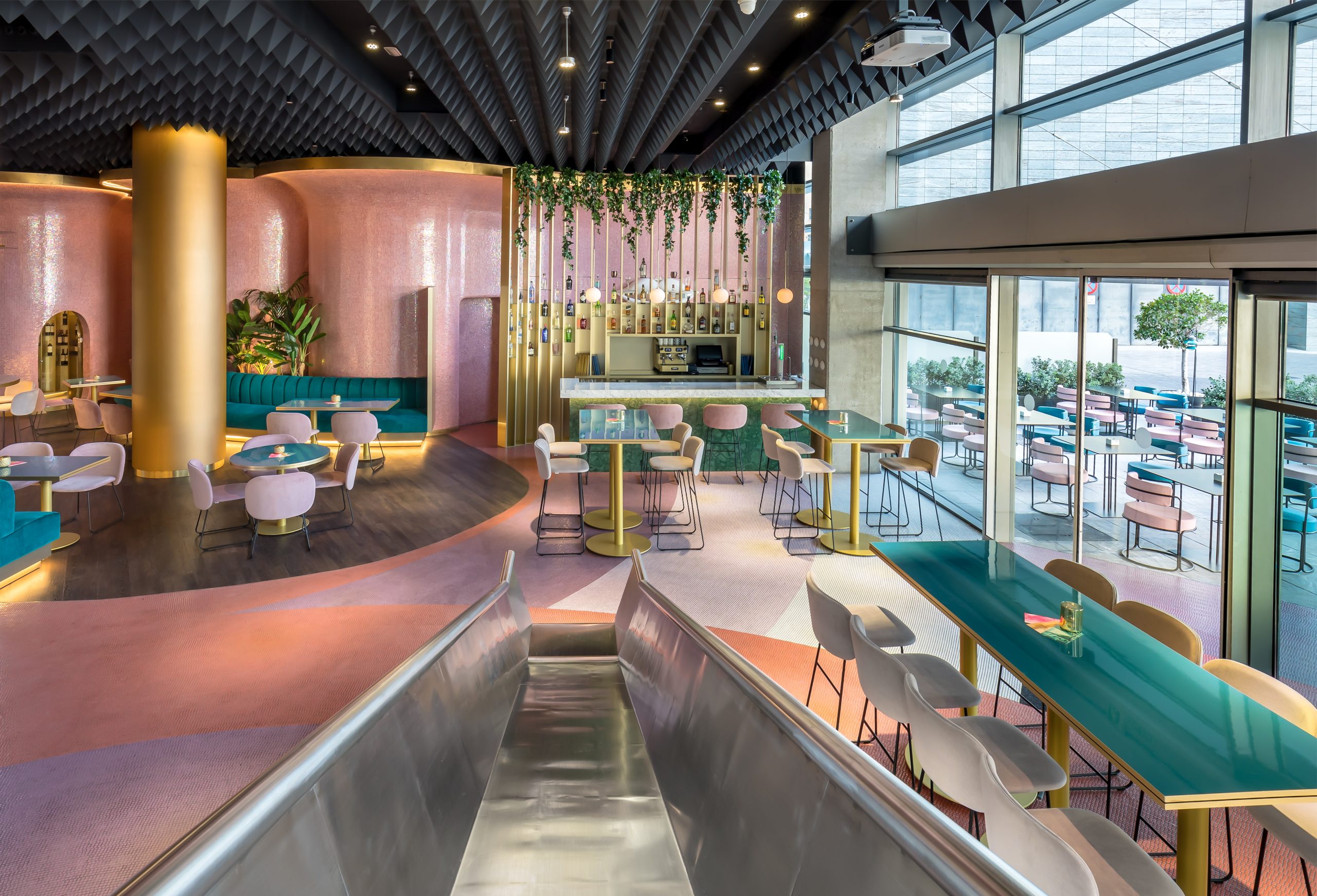The province of Málaga offers countless attractions to the visitor who may be wondering what to see around the city of Málaga itself, along the Costa del Sol or in the inland mountain ranges. It is by no means easy to choose between spending a day on an idyllic beach, wandering the streets of a captivating mountain village, or admiring wonders of nature such as El Torcal de Antequera, the Los Gaitanes gorge, or the Sierra de las Nieves.
If you leave the capital city, you can find quieter beaches than La Malagueta without travelling far, while some pretty towns and villages (Churriana, Alhaurín de la Torre, or Campanillas) are to be found in the same district; if however you look beyond that to the rest of the province, the list of places worth visiting on a leisurely day out becomes quite staggering.
That is why this tourist guide to the province of Málaga cannot, and does not, claim to be exhaustive; it is a carefully considered selection of the attractions offered by Málaga, which aims both to guide visitors and to encourage them to explore corners that lie beyond merely practical considerations of time and space.
That is why this tourist guide to the province of Málaga cannot, and does not, claim to be exhaustive; it is a carefully considered selection of the attractions offered by Málaga, which aims both to guide visitors and to encourage them to explore corners that lie beyond merely practical considerations of time and space.
CAPTIVATING TOWNS IN MALAGA
Related experiences
Ronda
How do we begin to list the attractions of Ronda, the city divided by the El Tajo gorge? They will be many, obviously, if they have in the past captured the hearts of such renowned travellers as Ernest Hemingway and Orson Welles. No visit to Ronda would be complete without a low-angle shot of the Puente Nuevo [New Bridge], nor should any visitor miss the view from the Del Coño viewing point, even if its name does sound like an obscenity in Spanish. (It appears to have been christened El Coño by the residents, after the exclamation uttered by so many visitors on seeing the incredible views.) Ronda, moreover, is a prodigious wine-producing area (you can visit vineyards and bodegas here), and has a strong bullfighting tradition (the Goyesca bullfight is held every year in its eighteenth-century bullring).

Ronda is one of Málaga’s white towns, so recognisable with their characteristic architecture — whitewashed houses, balconies and windows full of flowers, and narrow, cobbled streets that invite the visitor to meander aimlessly. Frigiliana (undoubtedly one of the province’s prettiest towns with its very well-preserved Moorish centre), Mijas (with its famous donkey-taxis traversing the streets), Antequera, Gaucín, and Casares are just a few of the towns that should be on any visitor’s itinerary.
Although Ronda may be one of the inland towns that attracts a great many tourists because of its culture and its unique location, there are a number of other white towns that are also worth a look around. Here we recommend five with particular attractions that make them stand out.
Frigiliana, a town characterised by whitewash and flowers
Frigiliana, a town in the district of La Axarquía, is a ‘must’ on any tour of Málaga’s white towns. Its well-cared-for streets twist according to the lie of the land, and lead into side streets and courtyards brimming with flowers. In the centre of these towns, in addition to the dazzling white houses, there are also numerous historical monuments worth visiting. These include the church of San Antonio, the Santo Cristo de la Caña hermitage, the palace of the Condes de Frigiliana, (which is now home to a honey factory), and the remains of the Lízar castle.
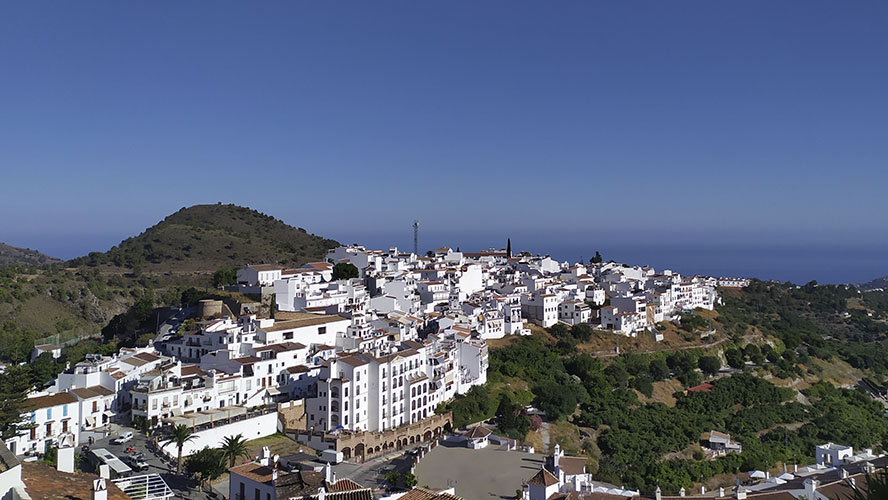
Mijas — from the mountains to the beach
The abiding image of Mijas is that of its donkey-taxis, but it would be unfair to just confine ourselves to this 1960s tourist cliché, given that Mijas has far more diverse and interesting offers for the visitor. To start with, its old town has been declared a Site of Historic and Artistic Interest, and there is as much to see inland as there is on the coast. In the town’s historic quarter, visitors should not miss the gardens and the Muralla viewing point, the bullring, the Virgen de la Peña hermitage, and the church of the Inmaculada Concepción.
Set aside time to pay a visit to the Centre for Contemporary Art, which displays works by Dalí and Miró, and even houses the world’s second-largest selection of Picasso ceramics.
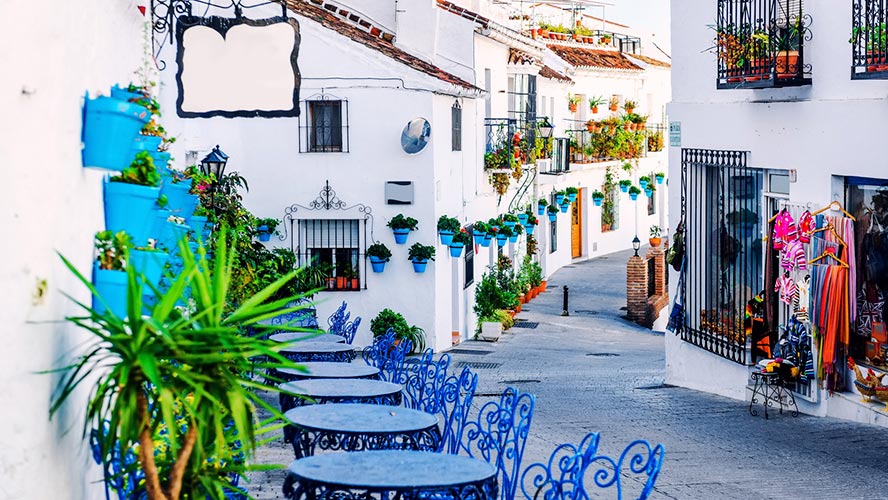
Antequera: an essential stop on your itinerary
It is worth stopping off at the town of Antequera, located in the heart of Andalusia, as much for its rich architectural heritage as for the natural beauty of El Torcal de Antequera, or for its superb complex of prehistoric dolmens, a UNESCO World Heritage Site.
We recommend you visit the picturesque El Portichuelo neighbourhood, and impressive monuments such as the Real Colegiata de Santa María la Mayor, the Nájera palace, the Convento de las Descalzas [Barefoot Sisters’ Convent], and the Palacio de los Marqueses de la Peña de los Enamorados [Palace of the Marquises of the Lovers’ Crag]. And, obviously, you’ll stay for lunch to try porra antequerana [Antequera-style gazpacho] or ajoblanco [chilled garlic and almond soup].
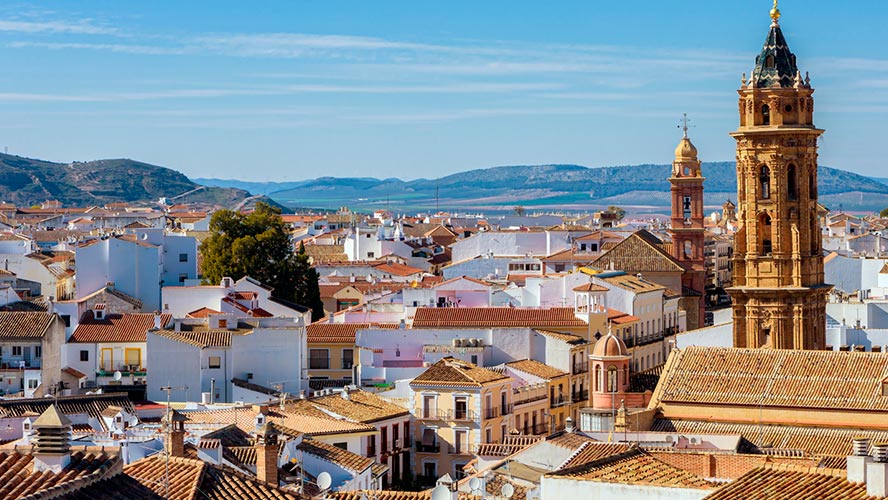
Gaucín, in the foothills of the Sierra
Known as the ‘Balcón de la Serranía’ [Balcony of the Mountain Range], Gaucín is one of those white towns that backs onto the mountain and offers superb views of the Sierra Crestellina. On your visit to this town, make sure you take a stroll through its narrow streets adorned with flowers, and that you at the very least visit the Castillo del Águila, the Santo Niño Hermitage and the San Sebastián parish church.
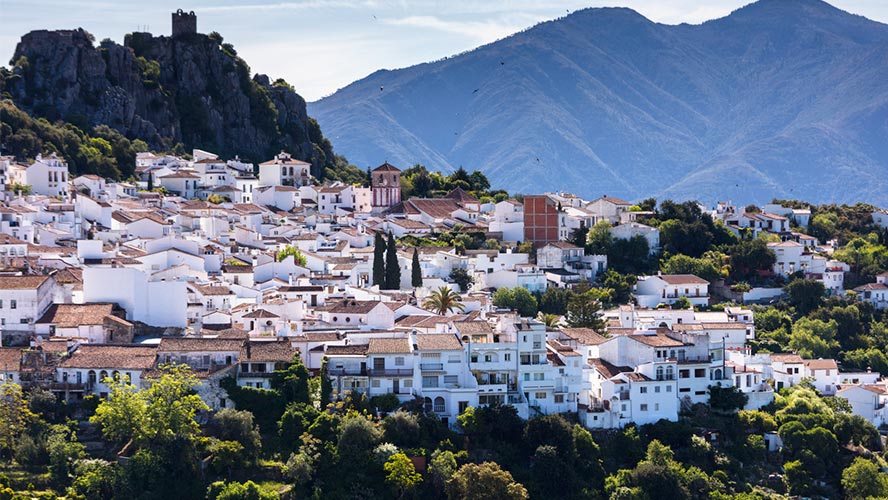
Casares, the birthplace of Blas Infante
This is another place that deserves to be included on any tour of Málaga’s white towns, both because of its dramatic appearance, perched on top of a hill, and because it is the birthplace of Blas Infante, known as the ‘Father of Andalusia’. The town lies between the Crestellina and Bermeja mountain ranges, and the surrounding scenery is magnificent. Its historic quarter offers a fine opportunity for a pleasant stroll; the town’s highlights are its castle; its church, the Iglesia de la Encarnación; the birthplace of Blas Infante, and the San Sebastián hermitage.
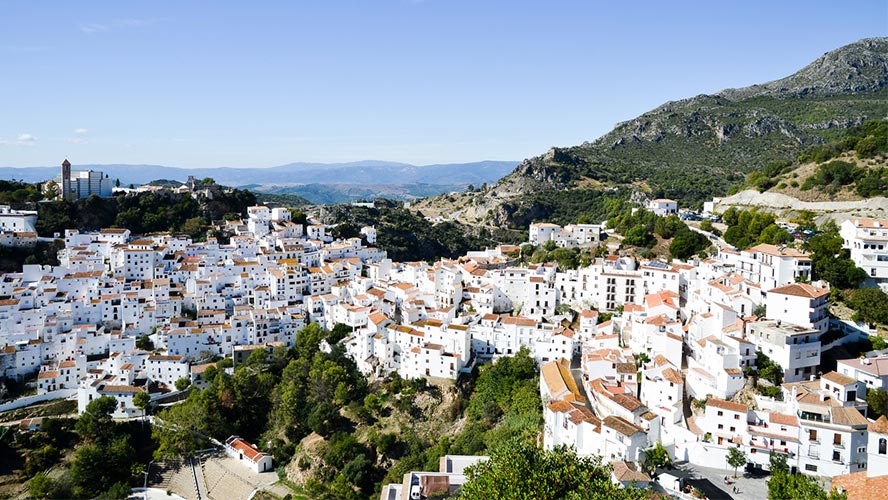
Yunquera
In the district of Sierra de las Nieves, this town (named by the Romans after the ‘juncos’ [reeds] that grow in the area) offers a fascinating blend of cultures that over time have evolved into its own, unique identity. The development of the town and its population has been influenced by Romans, Visigoths, Arabs and Christians and their respective requirements. Today it is a pleasure to walk along its white streets, and discover beautiful buildings — such as its church, the Iglesia de Nuestra Señora de la Encarnación, known as the “Catedral de la Serranía” [Cathedral of the Mountain Range] because of its vast size. Nor should visitors miss the La Cruz del Pobre hermitage next to the cemetery; the Torrecilla Árabe, the Hermitage of Nuestra Señora de Porticate, or the Paco Sola House-Museum.
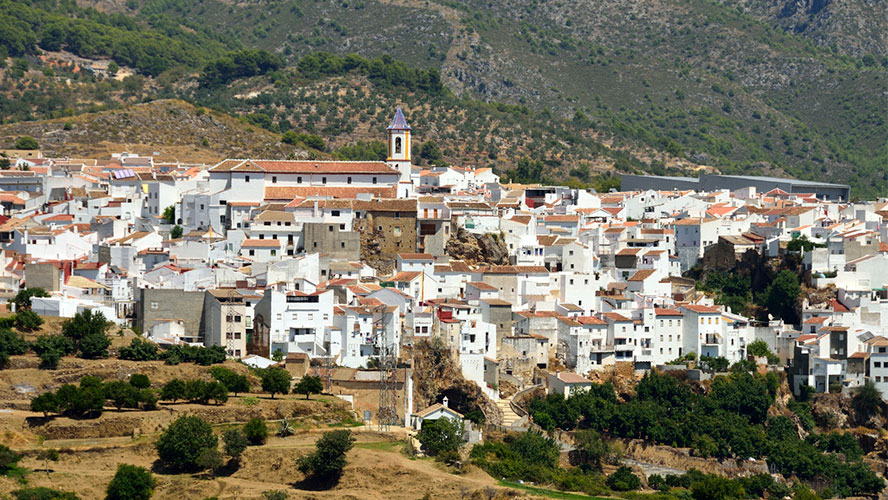
Ardales
This little town in the Guadalteba district, on the northern face of the Sierra de las Nieves, was always a place of great charm, but owes much of its current fame to the success of the Caminito del Rey walkway. As well as enjoying the spectacular scenery, we recommend that you visit the Bobastro ruins, the Castillo de la Peña and the Castillo de Turón, around 3 kilometres away. In the town centre, you will find the church of Nuestra Señora de los Remedios and the Convento de los Capuchinos. But there’s more to do besides visiting historical monuments: while you are in Ardales for example, take the opportunity to try a roast goat kid stew — the perfect way to round off your visit.
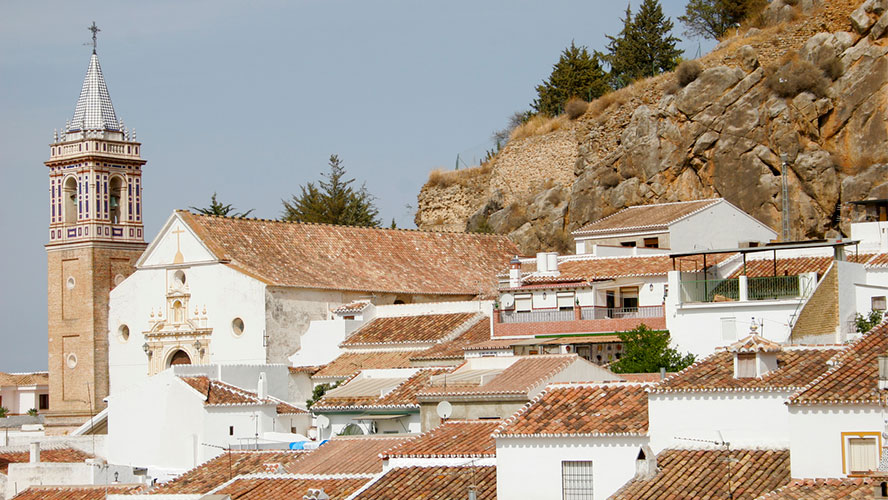
Júzcar
Unless you’re from Málaga, the name of Júzcar probably will not mean anything to you, but if we tell you that it was nicknamed ‘the town of the Smurfs’ because all the houses were painted blue for an advertising campaign, it may ring a bell. Apart from that story, this town also has a certain charm. It is located in the Serranía de Ronda, in the Valle del Genal Natural Park, and is an ideal place to spend a weekend if you like hiking or canyoning. Or even if you are religious and you want to follow the Fray Leopoldo Trail.
In the centre of the town you will find the sixteenth-century church of Santa Catalina, the ruins of the Tinplate Factory and the Mycology Museum. This town in the Sierra de Málaga will certainly not disappoint.
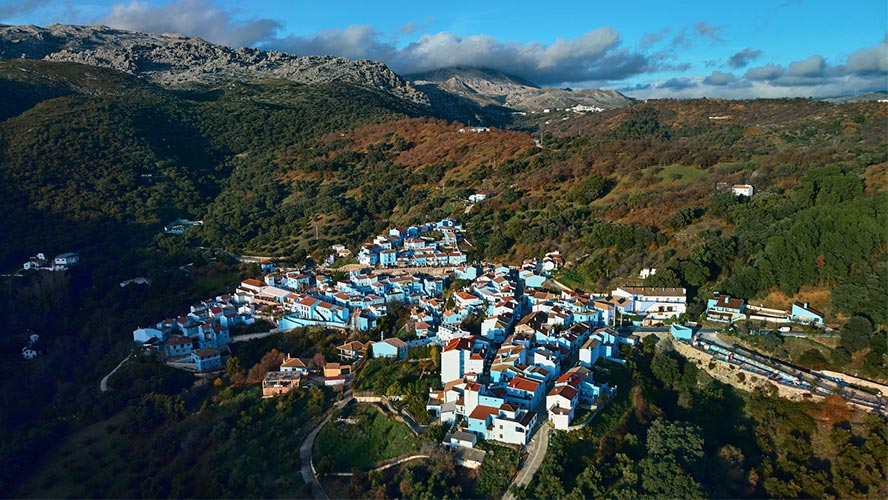
Álora
The profile of Álora viewed from a distance really could not be more appealing, with its scattering of white houses that seem to be walking towards the castle on the top of the hill. The town is in the Valle del Guadalhorce, and has a wealth of history. If you decide to visit Álora, you won’t be disappointed because you can do all kinds of things, ranging from a hike through the gorge, the Desfiladero de los Gaitanes, to strolling around the town centre and visiting the castle. Among its monuments, the highlights are the church of Nuestra Señora de la Encarnación, the Virgen de las Flores convent and a number of chapels. And if you want to learn about the area’s archaeology, make for the Rafael Leria Municipal Museum.
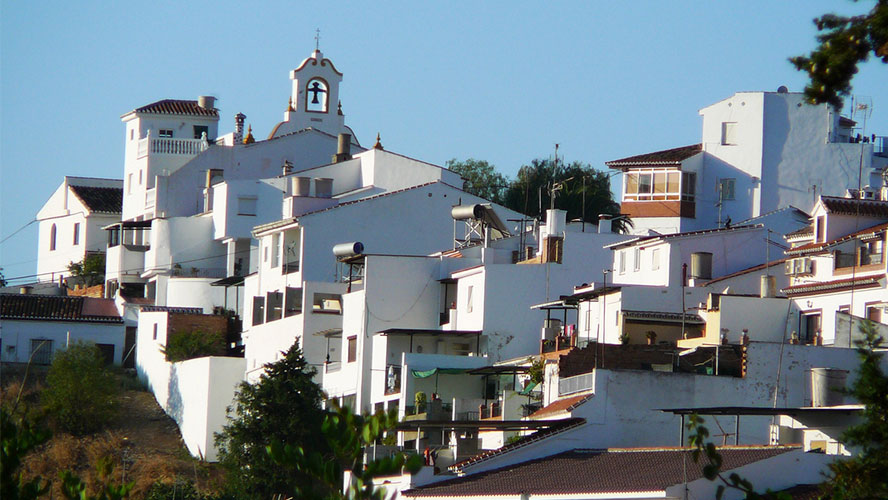
Alpandeire
To visit the attractive white town of Alpandeire, you should make your way to the Valle del Genal in the Jarastepar mountain range. Though a small village’ with less than 300 inhabitants, Alpandeire is a delightful place, and is the birthplace of Fray Leopoldo de Alpandeire, one of Andalusia’s most revered saints. This therefore is one of the villages on the saint’s hiking trail.
In the centre of the village, don’t miss the church of San Antonio de Padua, known as the Catedral de la Serranía, where it is said that Fray Leopoldo was baptised. Nor will you want to miss the house where he was born, or the Mirador del santo [Saint’s Viewing Point].
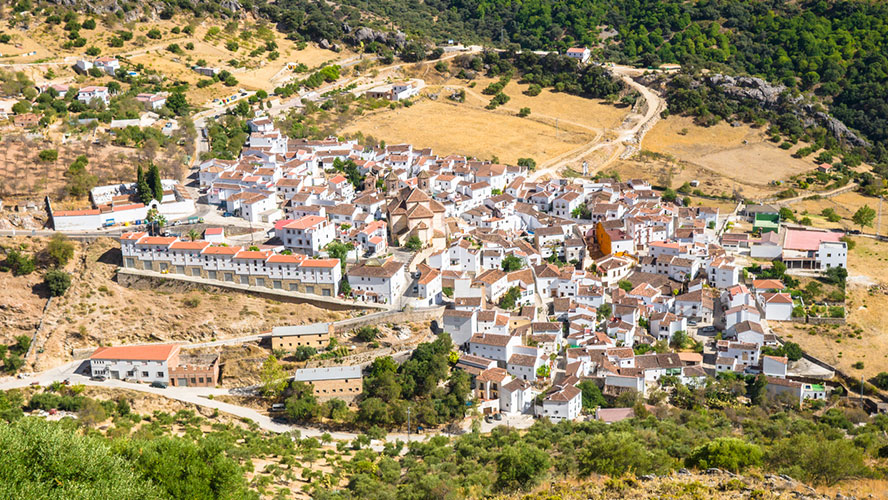
MALAGA’S MOST PICTURESQUE COASTAL TOWNS
Málaga has the good fortune to possess 160 kilometres of coastline, and at least ten towns are bathed by the warm waters of the Mediterranean. The Costa del Sol is one of Spain’s most popular tourist areas offering sun and sand. Here is a run down of the coastal towns and villages, picking out the most attractive that you may wish to include in your tour.
Marbella, the most popular town
The town of Marbella stands out on the coast like another world, synonymous with luxury, exclusivity and glamour. You can enjoy gazing at the yachts and sports cars in Puerto Banús, go shopping at boutiques selling the top brands and enjoy the vibrant nightlife — all good incentives to visit Marbella. And it’s a good idea to visit San Pedro de Alcántara, a quiet town with a beautiful beach, only 15 kilometres away.
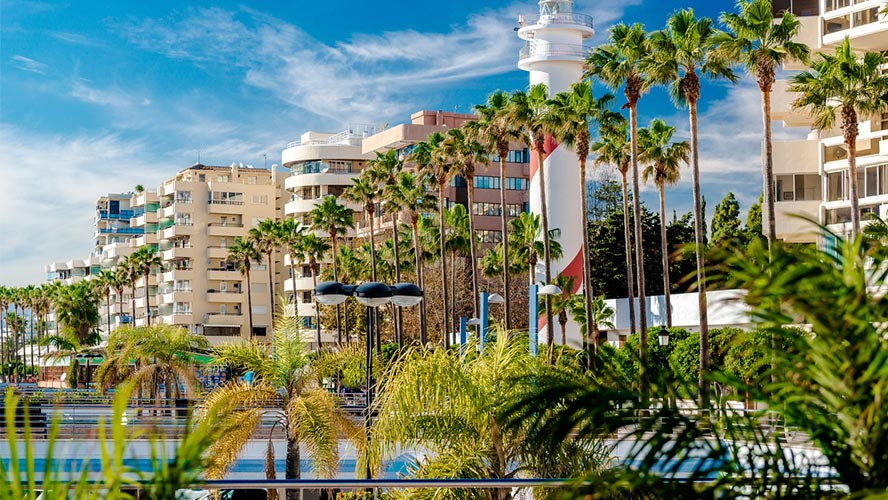
Nerja, the Blue Summer town
Having developed its tourism offer over several decades, Nerja is always an interesting excursion from Málaga — and it’s only 50 kilometres away. Here you can spend time on the beach, and see the sights of the town centre, including the El Salvador church, the hermitage of Nuestra Señora de las Angustias, and the Señora de las Maravillas parish church. Any travellers who remember the Spanish TV series ‘Verano Azul’ [Blue Summer], filmed in Nerja in the 1980s, may be interested in visiting the park which is home to Chanquete’s boat.
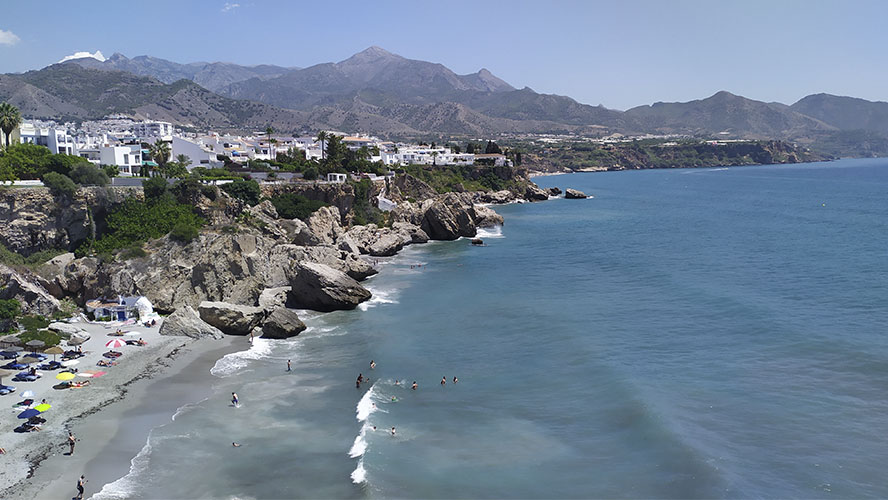
Estepona, a quintessential Andalusian town
This town of just over 60,000 inhabitants has carved itself a niche in the Costa del Sol as a beach resort and a characterful town. In addition to its well-cared-for historic quarter with its white houses, little squares, churches and flourishing bougainvillea, Estepona has a few unusual features. You can enjoy the street art, as there are sculptures and graffiti dotted all about, and don’t leave without visiting the Estepona Orchidarium, which is home to over 1,300 orchid species.
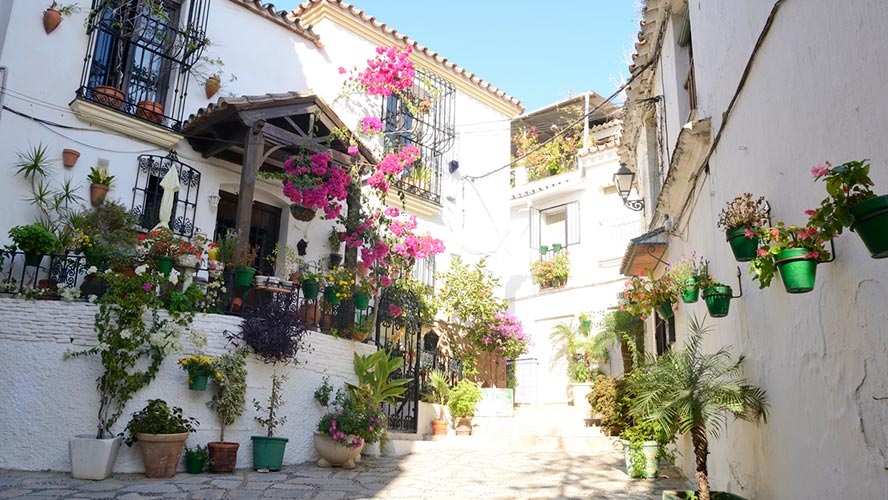
Fuengirola — a cosmopolitan town
Slightly larger than Estepona, Fuengirola is a friendly town with residents from over 120 countries in the world who have been drawn here by the pleasant climate and the coastal location.The town’s tourist highlights are the Sohail castle, the bullring (built in1962), and the Finca del Secretario archaeological site. And if you’re travelling with children, we also recommend the Fuengirola Bioparc, where you can see more than 130 species of animals from all over the world.
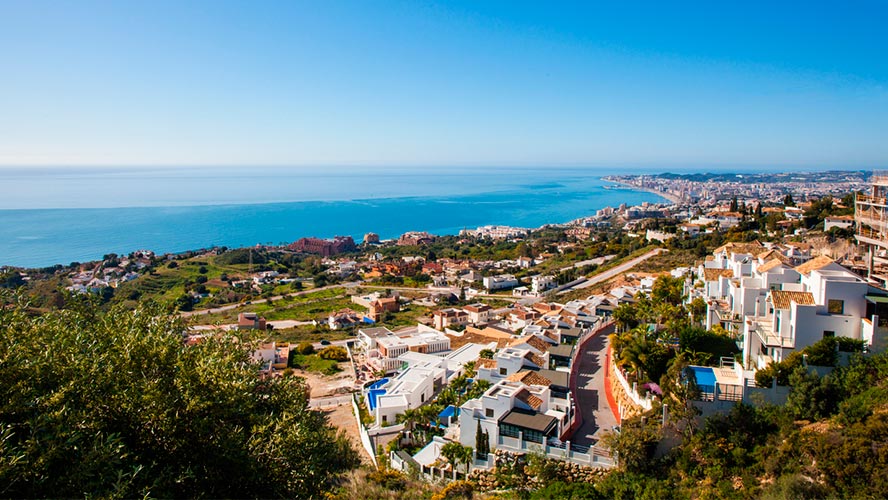
Torremolinos, always in style
Few holiday destinations can say that they haven’t become outdated in over five decades, and Torremolinos is one of them. Anyone who is only familiar with the image of Torremolinos found in the films of the 70s is missing out on the town’s culture, its good beaches, and countless leisure options. It is an ideal place for a family holiday, as it has 9 kilometres of easily accessible beaches and a full range of services and facilities. It will also suit anyone who enjoys a town environment but still wants to enjoy picturesque scenery. The icing on the cake is provided by the town’s enormous choice of restaurants and cuisine.
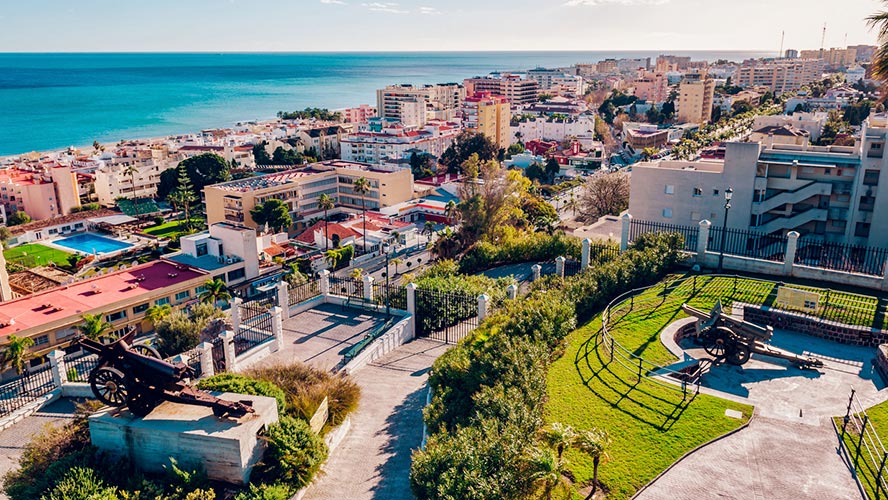
Benalmádena, a destination with a difference
Benalmádena is only 20 kilometres from Málaga and has its own unique offer of leisure activities. Benalmádena has definitely carved itself a niche on the Costa del Sol With its delightful historic quarter and 15 lovely beaches, it also offers something different in terms of places to visit: the Felipe Orlando Pre-Colombian Art Museum, the Buddhist Illumination Temple, and the castles of Colomares and Bil Bil.
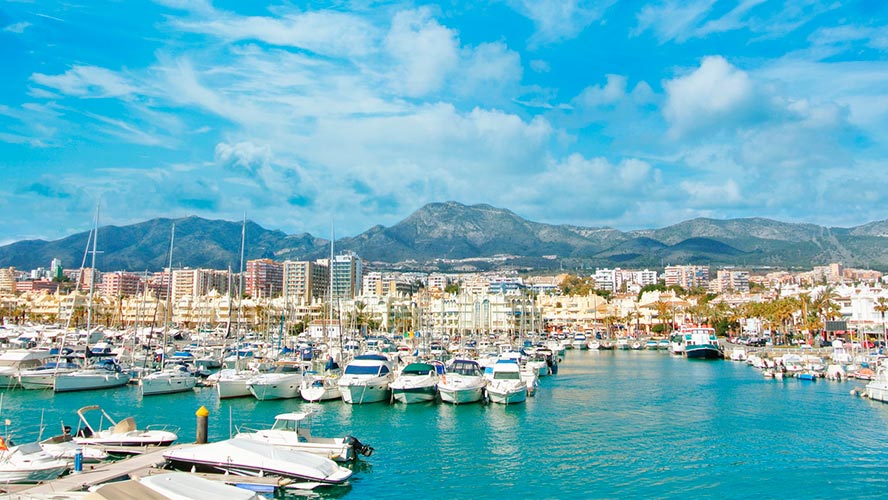
Hiking trails near Málaga
Málaga is much more than just beaches. The province has many parks and nature reserves in its mountain ranges that have been equipped with hiking trails for all levels:
The Great Málaga Path
Also known as GR 249, this is a scheme that encourages walkers to tour the entire province in 35 stages (a total of 739 km). This great trail links existing paths and traverses 57 municipalities, and ten or so protected natural landscapes. The stages are rather oddly classified under ‘body’, ‘mind’ and ‘emotions’, as the Gran Senda de Málaga offers space for physical exercises and different sports, for the development of the mind and the enjoyment of culture, and for connecting with nature and with oneself.
El Caminito del Rey
This is a former service walkway pinned around the inside of the Gaitanes gorge, which was repaired and reopened to the public a few years ago. It offers a short walk of approximately 3 kilometres that actually takes a couple of hours, as it inevitably includes occasional stops to take photographs. The Caminito has a tragic history (it was in a bad state prior to its restoration, and a number of people died when they risked walking along it), but the only risk nowadays is dizziness.
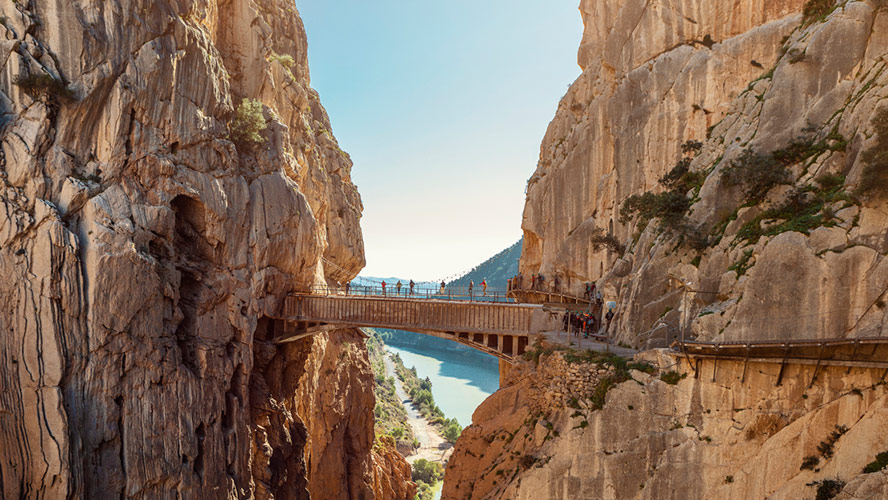
The Torcal de Antequera
The rocky landscape of El Torcal de Antequera is hard to describe as there is nothing else quite like it, and if it wasn’t in the province of Málaga, it could easily be on another planet. On El Torcal there is a network of well-signposted public walking trails, of varying distances and levels of difficulty. In addition, El Torcal, has an Interpretation Centre which provides an explanation of how the landscape’s weird rock formations were shaped by wind and water.
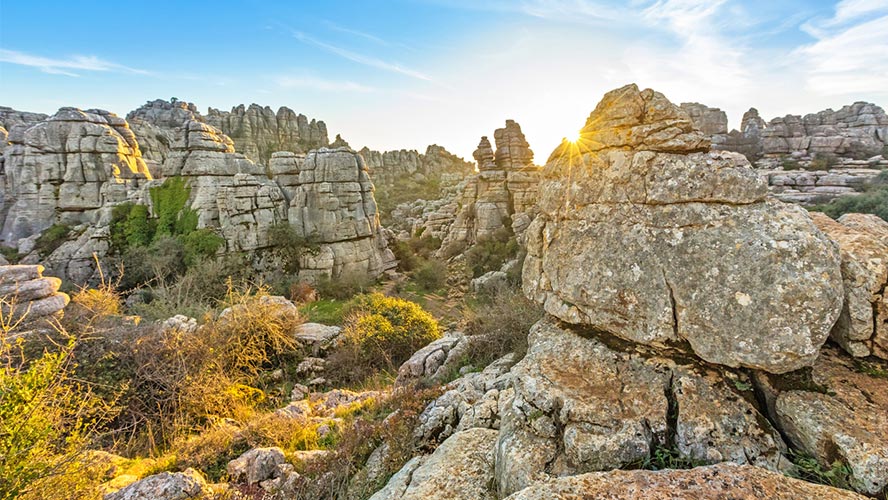
Routes through the Sierra de las Nieves
Located in the heart of the province to the east of the town of Ronda, the Sierra de las Nieves offers great contrasts between its snowy winter landscapes with the reddish appearance of the land soon after the snow melts. The natural park can be explored on foot using the designated paths.
As Málaga has so much to offer the visitor, the best course is to just relax (you really cannot go wrong, whatever your choice), and enjoy your stay before beginning to plan your next one as soon as possible.
Málaga’s beaches
Málaga is one of those exceptional regions which is as generously blessed with mountain landscapes as it is with coastline. That makes it very easy to combine both options: you can go walking inland and then round off the day by enjoying a swim in the Mediterranean. If you’re looking for options along the coast, below we have listed some of the beaches that you should visit in the province of Málaga.
Playa del Cristo
This sandy beach in the south-west of Estepona, near the marina, is a good spot where you can go and have a dip, then have a drink at a beach bar, and even listen to live music on weekends during the summer. An added advantage is that you can park nearby, and there is access for people with reduced mobility. If you’re travelling as a family, it’s also worth knowing that there are play areas and trees to provide shade if the sun is very strong.
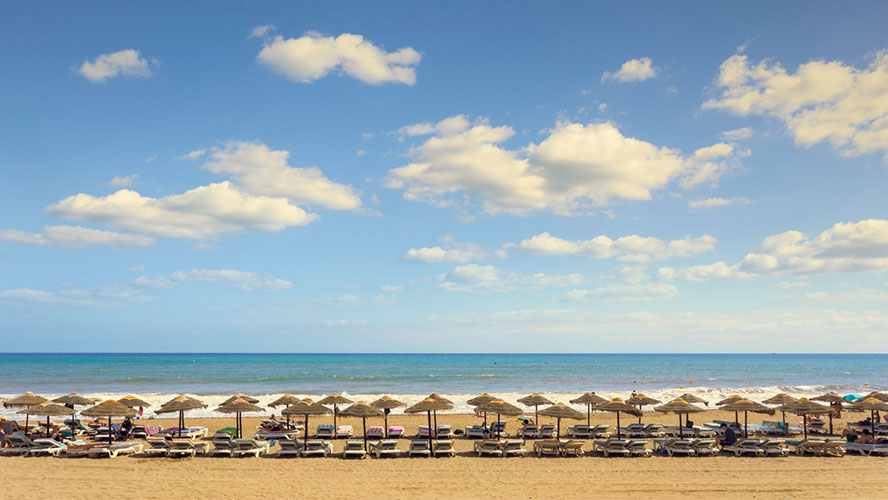
El Castillo-Ejido beach
El Ejido beach is in Fuengirola, and is the first beach you come to if you’re travelling from Marbella. The beach’s other name, El Castillo, comes from its location near the Sohail castle. The beach is around 800 metres long by 50 metres wide, and it is ideal for families, as the waves are gentle, there are sunshades and sun loungers for hire, and there are restaurants — and to round off the day, you could even visit the castle. If you have pets, they are allowed onto the beach too.
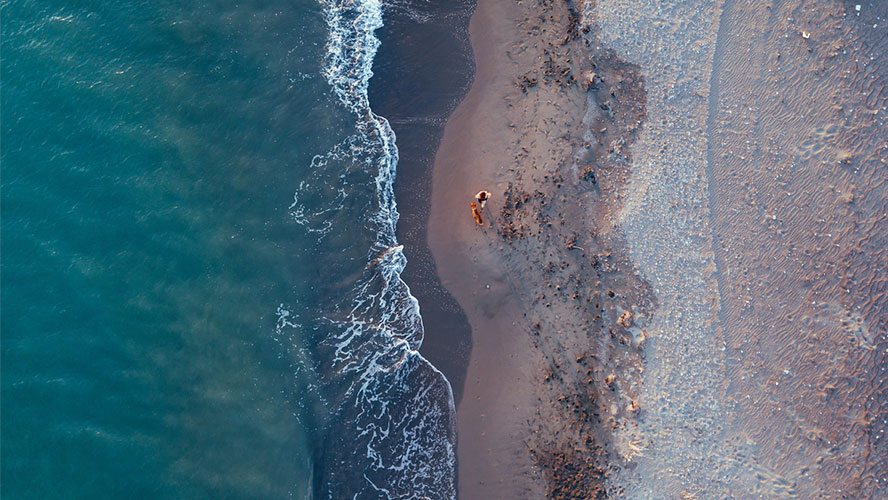
Playa de Cabopino
This is one of Marbella’s most pleasant natural spaces, a place where you can disconnect or have fun together as a family. Artola-Cabopinto beach is 1,200 metres long, and lies within the Dunas de Artola Natural Landscape, which has been a Natural Monument since 2001. This beach of fine, golden sands offers every service that bathers could require, from loungers for hire to restaurants and beach bars where visitors can enjoy delicious Málaga cuisine. There are also some beaches suitable for nude bathing.
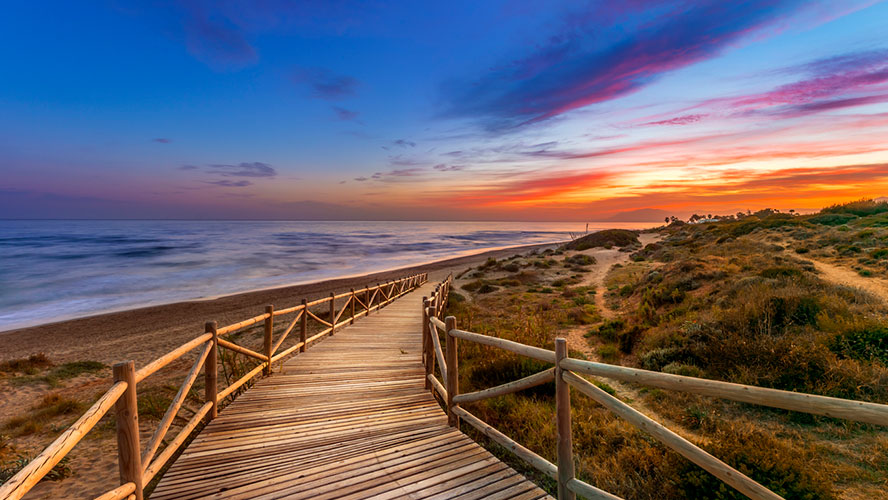
Playa de Maro
The small, wild beach of Maro is one of those magical corners of Nerja that we’re always happy to visit when on holiday. It has coarse sand and is edged with foliage, but it is a joy to step into its clear waters for snorkelling, or even a diving session. If you enjoy rowing, you have the option of arriving at the beach from Burriana in a kayak, rather than driving.
